Giraffe
| Giraffe | |
|---|---|

| |
| Giraffa tippelskirchi, Mikumi National Park, Tanzania | |
| Scientific classification | |
| Domain: | Eukaryota |
| Kingdom: | Animalia |
| Phylum: | Chordata |
| Class: | Mammalia |
| Order: | Artiodactyla |
| Family: | Giraffidae |
| Genus: | Giraffa Brisson, 1772 |
| Type species | |
| Giraffa camelopardalis | |
| Species | |

| |
| Range map of extant Giraffa divided by species and subspecies. | |
The giraffe (Giraffa) is a genus of African even-toed ungulate mammals, the tallest living terrestrial animals and the largest ruminants. The genus consists of eleven species including Giraffa camelopardalis, the type species. Seven of these species are extinct, prehistoric species known from fossils, while four are still extant. Whereas Giraffa once was thought to contain a single extant species with numerous subspecies, research into the mitochondrial and nuclear DNA of Giraffa has revealed four to six distinct extant species. The four-species taxonomic classification has the genus Giraffa composed of the species Giraffa giraffa (southern giraffe), Giraffa tippelskirchi (Masai giraffe), Giraffa reticulata (reticulated giraffe) and Giraffa camelopardalis (northern giraffe).
The giraffe's chief distinguishing characteristics are its extremely long neck and legs, its horn-like ossicones, and its distinctive coat patterns. It is classified under the family Giraffidae, along with its closest extant relative, the okapi. Each of the four species is distinguished by its coat patterns and genetics. Its scattered range extends from Chad in the north to South Africa in the south, and from Niger in the west to Somalia in the east. Giraffes usually inhabit savannahs and woodlands. Their food source is leaves, fruits and flowers of woody plants, primarily acacia species, which they browse at heights most other herbivores cannot reach. Giraffes may be preyed on by lions, leopards, spotted hyenas and African wild dogs. Giraffes live in herds of related females and their offspring, or bachelor herds of unrelated adult males, but are gregarious and may gather in large aggregations. Males establish social hierarchies through "necking", which are combat bouts where the neck is used as a weapon. Dominant males gain mating access to females, which bear the sole responsibility for raising the young.
The giraffe has intrigued various cultures, both ancient and modern, for its peculiar appearance, and has often been featured in paintings, books, and cartoons. It is classified by the International Union for Conservation of Nature as Least Concern, but has been extirpated from many parts of its former range, and three subspecies are classified as Endangered. Nevertheless, giraffes are still found in numerous national parks and game reserves. Estimations as of 2016 indicate that there are approximately 90,000 members of Giraffa in the wild, with around 1,144 in captivity.
Etymology
The name "giraffe" has its earliest known origins in the Arabic word zarāfah (زرافة),[1] perhaps borrowed from the animal's Somali name geri.[2] The Arab name is translated as "fast-walker".[3] There were several Middle English spellings, such as jarraf, ziraph, and gerfauntz.[1] The Italian form giraffa arose in the 1590s.[1] The modern English form developed around 1600 from the French girafe.[1] "Camelopard" is an archaic English name for the giraffe deriving from the Ancient Greek for camel and leopard, referring to its camel-like shape and its leopard-like colouring.[4][5]
Taxonomy
Living giraffes were originally classified as one species by Carl Linnaeus in 1758. He gave it the binomial name Cervus camelopardalis. Morten Thrane Brünnich classified the genus Giraffa in 1772.[6] The species name camelopardalis is from Latin.[7]
Evolution

The giraffe belongs to the suborder Ruminantia. Many ruminants have been described from the mid-Eocene in Central Asia, Southeast Asia, and North America. The earliest ruminants date back to about 50 million years ago. The Rumanantia arose from early artiodactyls, which experienced adaptive radiation in the middle Eocene period that led to adaptations related to herbivory. The oldest known artiodactyl lived in Holarctic of Pangea, which then occupied regions in North America, Europe, and Asia around 60-55 million years ago in the early Eucene.[8] The ecological conditions during this period may have helped them to disperse fast. The giraffe is one of only two living genera of the family Giraffidae, the other being the okapi. The family was once much more extensive, with over 10 fossil genera described. Their closest known relatives are the extinct deer-like climacocerids. They, together with the family Antilocapridae (whose only extant species is the pronghorn), belong to the superfamily Giraffoidea. These animals may have evolved from the extinct family Palaeomerycidae which might also have been the ancestor of deer.[9]
The elongation of the neck appears to have started early in the giraffe lineage. Comparisons between giraffes and their ancient relatives suggest that vertebrae close to the skull lengthened earlier, followed by lengthening of vertebrae further down.[10] One early giraffid ancestor was Canthumeryx which has been dated variously to have lived 25–20 million years ago (mya), 17–15 mya or 18–14.3 mya and whose deposits have been found in Libya. This animal was medium-sized, slender and antelope-like. Giraffokeryx appeared 15 mya in the Indian subcontinent and resembled an okapi or a small giraffe, and had a longer neck and similar ossicones.[9] Giraffokeryx may have shared a clade with more massively built giraffids like Sivatherium and Bramatherium.[10]
Giraffids like Palaeotragus, Shansitherium and Samotherium appeared 14 mya and lived throughout Africa and Eurasia. These animals had bare ossicones and small cranial sinuses and were longer with broader skulls.[9][10] Paleotragus resembled the okapi and may been its ancestor.[9] Others find that the okapi linage diverged earlier, before Giraffokeryx.[10] Samotherium was a particularly important transitional fossil in the giraffe linage as its cervical vertebrae was intermediate in length and structure between a modern giraffe and an okapi, and was more vertical than the okapi's.[11] Bohlinia, which first appeared in southeastern Europe and lived 9–7 mya was likely a direct ancestor of the giraffe. Bohlinia closely resembled modern giraffes, having a long neck and legs and similar ossicones and dentition.[9]

Bohlinia entered China and northern India in response to climate change. From here, the genus Giraffa evolved and, around 7 mya, entered Africa.[12] Further climate changes caused the extinction of the Asian giraffes, while the African giraffes survived and radiated into several new species. Living giraffes appear to have arisen around 1 mya in eastern Africa during the Pleistocene.[9] Some biologists suggest the modern giraffes descended from G. jumae;[13] others find G. gracilis a more likely candidate.[9] G. jumae was larger and more heavily built while G. gracilis was smaller and more lightly built. The main driver for the evolution of the giraffes is believed to have been the changes from extensive forests to more open habitats, which began 8 mya.[9] During this time, tropical plants disappeared and were replaced by arid C4 plants, and a dry savannah emerged across eastern and northern Africa and western India.[14][15] Some researchers have hypothesised that this new habitat coupled with a different diet, including acacia species, may have exposed giraffe ancestors to toxins that caused higher mutation rates and a higher rate of evolution.[16] The coat patterns of modern giraffes may also have coincided with these habitat changes. Asian giraffes are hypothesised to have had more okapi-like colourations.[9]
In the early 19th century, Jean-Baptiste Lamarck believed the giraffe's long neck was an "acquired characteristic", developed as generations of ancestral giraffes strove to reach the leaves of tall trees.[17] This theory was eventually rejected, and scientists now believe the giraffe's neck arose through Darwinian natural selection—that ancestral giraffes with long necks thereby had a competitive feeding advantage (competing browsers hypothesis)[18] that better enabled them to survive and reproduce to pass on their genes.[17]
The giraffe genome is around 2.9 billion base pairs in length compared to the 3.3 billion base pairs of the okapi. Of the proteins in giraffe and okapi genes, 19.4% are identical. The two species are equally distantly related to cattle, suggesting the giraffe's unique characteristics are not because of faster of evolution. The divergence of giraffe and okapi lineages dates to around 11.5 mya. A small group of regulatory genes in the giraffe appear to be responsible for the animal's stature and associated circulatory adaptations.[19]
Species and subspecies

A 2007 study on the genetics of Giraffa, which were thought to combine to compose a single giraffe species suggested they were six species: the West African, Rothschild's, reticulated, Masai, Angolan, and South African giraffe.[20] The study deduced from genetic drift in nuclear and mitochondrial DNA (mtDNA) that giraffes from these populations are reproductively isolated and rarely interbreed, though no natural obstacles block their mutual access. This includes adjacent populations of Rothschild's, reticulated, and Masai giraffes. The Masai giraffe was also suggested to consist of possibly two species separated by the Rift Valley.[20]
Reticulated and Masai giraffes have the highest mtDNA diversity, which is consistent with giraffes originating in eastern Africa. Populations further north are more closely related to the former, while those to the south are more related to the latter. Giraffes appear to select mates of the same coat type, which are imprinted on them as calves.[20] The implications of these findings for the conservation of giraffes were summarised by David Brown, lead author of the study, who told BBC News: "Lumping all giraffes into one species obscures the reality that some kinds of giraffe are on the brink. Some of these populations number only a few hundred individuals and need immediate protection."[21]
A 2016 study confirmed that living giraffes consist of multiple species. The researchers supported the existence of four species, which have not exchanged genetic information between each other for 1 million to 2 million years. Those four species are the northern giraffe (Giraffa camelopardalis), southern giraffe (Giraffa giraffa), reticulated giraffe (Giraffa reticulata), and Masai giraffe (Giraffa tippelskirchi). Both southern and northern giraffe have two and three distinct subspecies respectively; Angolan giraffe (G. g. angolensis) and South African giraffe (G. g. giraffa) for southern giraffe, and the Kordofan giraffe (G. c. antiquorum), Nubian giraffe (G. c. camelopardalis) and West African giraffe (G. c. peralta) for northern giraffe.[22]
Up to four species, and five subspecies, of giraffe are recognized (with population estimates as of 2016[update]). Two former subspecies (Rothschild's giraffe and Rhodesian giraffe) are also included. There are an estimated 89,710 individuals of Giraffa in the wild, with 1,144 currently in captivity.[22][23]
| Species | Subspecies | Description | Image |
|---|---|---|---|
| Northern giraffe (G. camelopardalis) | Kordofan giraffe (G. c. antiquorum) | The Kordofan giraffe has a distribution which includes southern Chad, the Central African Republic, northern Cameroon, and north-eastern DR Congo.[24] Populations in Cameroon were formerly included in G. c. peralta, but this was incorrect.[25] Compared to the Nubian giraffe, this subspecies has smaller and more irregular spotting patterns. Its spots may be found below the hocks and the insides of the legs. A median lump is present in males.[26]: 51–52 Some 2,000 are believed to remain in the wild.[22] Considerable confusion has existed over the status of this subspecies and G. c. peralta in zoos. In 2007, all alleged G. c. peralta in European zoos were shown to be, in fact, G. c. antiquorum.[25] With this correction, about 65 are kept in zoos.[23] The formerly recognised subspecies G. c. congoesis is now considered part of Kordofan subspecies. | 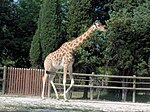
|
| Nubian giraffe, (G. c. camelopardalis)[27] | The nominate subspecies of the northern giraffe, is found in eastern South Sudan and south-western Ethiopia,[24] in addition to Kenya and Uganda.[22] It has sharply defined chestnut-coloured spots surrounded by mostly white lines, while undersides lack spotting.[24] The median lump is particularly developed in the male.[26]: 51 Around 2,150 are thought to remain in the wild, with 1,500 individuals belonging to the Rothschild ecotype. Due to the addition of Rothschild's giraffe to the Nubian subspecies, the Nubian giraffe is very common in captivity, although the original phenotype is rare- a group is kept at Al Ain Zoo in the United Arab Emirates.[28] In 2003, this group numbered 14.[29] | 
| |
| West African giraffe (G. c. peralta),[27] also known as Niger giraffe or Nigerian giraffe[30] | The West African giraffe is endemic to south-western Niger.[24][31] This animal has a lighter pelage than other subspecies,[32]: 322 with red lobe-shaped blotches that reach below the hocks. The ossicones are more erect than in other subspecies and males have well-developed median lumps.[26]: 52–53 It is the most endangered subspecies within Giraffa, with 400 individuals remaining in the wild.[22] Giraffes in Cameroon were formerly believed to belong to this subspecies, but are actually G. c. antiquorum.[25] This error resulted in some confusion over its status in zoos, but in 2007, it was established that all "G. c. peralta" kept in European zoos actually are G. c. antiquorum. The same 2007 study found that The West African giraffe was more closely related to the Rothchild's giraffe than the Kordofan and its ancestor may have migrated from eastern to northern Africa and then to its current range with the development of the Sahara Desert. At its largest, Lake Chad may have acted as a barrier between West African and Kordofan giraffes during the Holocene (before 5000 BC).[25] | 
| |
| Rothschild's giraffe ("G. c. rothschildi", after Walter Rothschild),[27] also known as Baringo giraffe or Ugandan giraffe | The Rothschild's giraffe is now considered an ecotype of the northern giraffe (Giraffa camelopardalis). Its range includes parts of Uganda and Kenya.[24][31] Its presence in South Sudan is uncertain.[33] This giraffe has large dark patches that usually have complete margins, but may also have sharp edges. The dark spots may also have paler radiating lines or streaks within them. Spotting does not often reach below the hocks and almost never to the hooves. This ecotype may also develop five "horns".[26]: 53 Around 1,500 individuals believed to remain in the wild,[22] and more than 450 are kept in zoos.[23] According to genetic analysis circa September 2016, it is conspecific with the Nubian giraffe (G. c. camelopardalis).[22] | 
| |
| Reticulated giraffe (G. reticulata),[27] also known as Somali giraffe | The reticulated giraffe is native to north-eastern Kenya, southern Ethiopia, and Somalia.[24] Its distinctive coat pattern consists of sharp-edged, reddish brown polygonal patches divided by a network of thin white lines.[24] Spots may or may not extend below the hocks, and a median lump is present in males.[26]: 53 An estimated 8,660 individuals remain in the wild,[22] and based on International Species Information System records, more than 450 are kept in zoos.[23] | 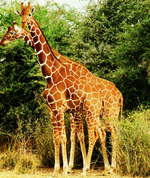
| |
| Southern giraffe (G. giraffa) | Angolan giraffe (G. g. angolensis), also known as Namibian giraffe | The Angolan giraffe is found in northern Namibia, south-western Zambia, Botswana, and western Zimbabwe.[24] A 2009 genetic study on this subspecies suggested the northern Namib Desert and Etosha National Park populations form a separate subspecies.[34] This subspecies has large brown blotches with edges that are either somewhat notched or have angular extensions. The spotting pattern extends throughout the legs but not the upper part of the face. The neck and rump patches tend to be fairly small. The subspecies also has a white ear patch.[26]: 51 An estimated 13,000 animals are estimated to remain in the wild;[22] and about 20 are kept in zoos.[23] | 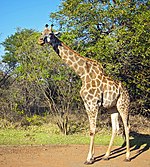
|
| South African giraffe (G. g. giraffa) | The South African giraffe is found in northern South Africa, southern Botswana, southern Zimbabwe, and south-western Mozambique.[24] It has dark, somewhat rounded patches "with some fine projections" on a tawny background colour.[24] The spots extend down the legs and get smaller. The median lump of males is less developed.[26]: 52 A maximum of 31,500 are estimated to remain in the wild,[22] and around 45 are kept in zoos.[23] | 
| |
| Masai giraffe (G. tippelskirchi) | Masai giraffe (G. tippelskirchi), also known as Kilimanjaro giraffe | The Masai giraffe can be found in central and southern Kenya and in Tanzania.[24] It has distinctive, irregular, jagged, star-like blotches which extend to the hooves.[24] A median lump is usually present in males.[26]: 54 [35] A total of 32,550 are thought to remain in the wild,[22] (including the Rhodesian ecotype) and about 100 are kept in zoos.[23] | 
|
| Rhodesian giraffe ("G. c. thornicrofti", after Harry Scott Thornicroft),[27] also known as Thornicroft giraffe | The Rhodesian giraffe is an ecotype of the Masai giraffe (G. tippelskirchi) restricted to the Luangwa Valley in eastern Zambia.[24] The patches are notched and somewhat star-shaped, and may or may not extend across the legs.[24] The median lump of males is underdeveloped.[26]: 54 No more than 550 remain in the wild,[22] with none kept in zoos.[23] According to the 2016 genetic analysis, it is synonymous with the Masai giraffe (G. tippelskirchi).[22] | 
| |
There are also seven extinct species of giraffe, listed as the following-
- †Giraffa gracilis
- †Giraffa jumae
- †Giraffa priscilla
- †Giraffa punjabiensis
- †Giraffa pygmaea
- †Giraffa sivalensis
- †Giraffa stillei
G. attica, also extinct, was formerly considered part of Giraffa but was reclassified as Bohlinia attica in 1929.[5]
Appearance and anatomy
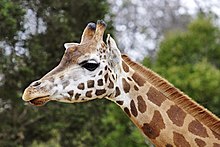
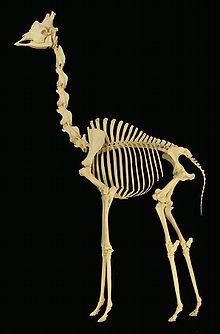

Fully grown giraffes stand 4.3–5.7 m (14.1–18.7 ft) tall, with males taller than females.[36][37][38] The tallest recorded male was 5.88 m (19.3 ft) and the tallest recorded female was 5.17 m (17.0 ft) tall.[36][39] The average weight is 1,192 kg (2,628 lb) for an adult male and 828 kg (1,825 lb) for an adult female[40] with maximum weights of 1,930 kg (4,250 lb) and 1,180 kg (2,600 lb) having been recorded for males and females, respectively.[37][38] Despite its long neck and legs, the giraffe's body is relatively short.[41]: 66 Located at both sides of the head, the giraffe's large, bulging eyes give it good all-round vision from its great height.[42]: 25 Giraffes see in colour[42]: 26 and their senses of hearing and smell are also sharp.[17] The animal can close its muscular nostrils to protect against sandstorms and ants.[42]: 27
The giraffe's prehensile tongue is about 45 cm (18 in) long.[37][38] It is purplish-black in colour, perhaps to protect against sunburn, and is useful for grasping foliage, as well as for grooming and cleaning the animal's nose.[42]: 27 The upper lip of the giraffe is also prehensile and useful when foraging. The lips, tongue, and inside of the mouth are covered in papillae to protect against thorns.[6]
The coat has dark blotches or patches (which can be orange, chestnut, brown, or nearly black in colour[17]) separated by light hair (usually white or cream in colour[17]). Male giraffes become darker as they age.[35] The coat pattern has been claimed to serve as camouflage in the light and shade patterns of savannah woodlands.[27] While adult giraffes standing among trees and bushes are hard to see at even a few metres' distance, they actively move into the open to gain the best view of an approaching predator, obviating any benefit that camouflage might bring. Instead, the adults rely on their size and ability to defend themselves. However, camouflage appears to be important for calves, which spend a large part of the day in hiding, away from their mothers; further, over half of all calves die within a year, so predation is certainly important. It appears, therefore, that the spotted coat of the giraffe functions as camouflage for the young, while adults simply inherit this coloration as a by-product.[9] The skin underneath the dark areas may serve as windows for thermoregulation, being sites for complex blood vessel systems and large sweat glands.[43] Each individual giraffe has a unique coat pattern.[35]
The skin of a giraffe is mostly gray.[40] Its thickness allows the animal to run through thorn bush without being punctured.[42]: 34 The fur may serve as a chemical defence, as its parasite repellents give the animal a characteristic scent. At least 11 main aromatic chemicals are in the fur, although indole and 3-methylindole are responsible for most of the smell. Because the males have a stronger odour than the females, the odour may also have sexual function.[44] Along the animal's neck is a mane made of short, erect hairs.[6] The one-metre (3.3-ft) tail ends in a long, dark tuft of hair and is used as a defense against insects.[42]: 36
Skull and ossicones
Both sexes have prominent horn-like structures called ossicones, which are formed from ossified cartilage, covered in skin and fused to the skull at the parietal bones.[35] Being vascularized, the ossicones may have a role in thermoregulation,[43] and are also used in combat between males.[45] Appearance is a reliable guide to the sex or age of a giraffe: the ossicones of females and young are thin and display tufts of hair on top, whereas those of adult males end in knobs and tend to be bald on top.[35] Also, a median lump, which is more prominent in males, emerges at the front of the skull.[6] Males develop calcium deposits that form bumps on their skulls as they age.[17] A giraffe's skull is lightened by multiple sinuses.[41]: 70 However, as males age, their skulls become heavier and more club-like, helping them become more dominant in combat.[35] The upper jaw has a grooved palate and lacks front teeth.[42]: 26 The giraffe's molars have a rough surface.[42]: 27
Legs, locomotion and posture
The front and back legs of a giraffe are about the same length. The radius and ulna of the front legs are articulated by the carpus, which, while structurally equivalent to the human wrist, functions as a knee.[46] It appears that a suspensory ligament allows the lanky legs to support the animal's great weight.[47] The foot of the giraffe reaches a diametre of 30 cm (12 in), and the hoof is 15 cm (5.9 in) high in males and 10 cm (3.9 in) in females.[42]: 36 The rear of each hoof is low and the fetlock is close to the ground, allowing the foot to provide additional support to the animal's weight.[6] Giraffes lack dewclaws and interdigital glands. The giraffe's pelvis, though relatively short, has an ilium that is outspread at the upper ends.[6]
A giraffe has only two gaits: walking and galloping. Walking is done by moving the legs on one side of the body at the same time, then doing the same on the other side.[35] When galloping, the hind legs move around the front legs before the latter move forward,[17] and the tail will curl up.[35] The animal relies on the forward and backward motions of its head and neck to maintain balance and the counter momentum while galloping.[32]: 327–29 The giraffe can reach a sprint speed of up to 60 km/h (37 mph),[48] and can sustain 50 km/h (31 mph) for several kilometres.[49]
A giraffe rests by lying with its body on top of its folded legs.[32]: 329 To lie down, the animal kneels on its front legs and then lowers the rest of its body. To get back up, it first gets on its knees and spreads its hind legs to raise its hindquarters. It then straightens its front legs. With each step, the animal swings its head.[42]: 31 In captivity, the giraffe sleeps intermittently around 4.6 hours per day, mostly at night.[50] It usually sleeps lying down, however, standing sleeps have been recorded, particularly in older individuals. Intermittent short "deep sleep" phases while lying are characterised by the giraffe bending its neck backwards and resting its head on the hip or thigh, a position believed to indicate paradoxical sleep.[50] If the giraffe wants to bend down to drink, it either spreads its front legs or bends its knees.[35] Giraffes would probably not be competent swimmers as their long legs would be highly cumbersome in the water,[51] although they could possibly float.[52] When swimming, the thorax would be weighed down by the front legs, making it difficult for the animal to move its neck and legs in harmony[51][52] or keep its head above the surface.[51]
Neck

The giraffe has an extremely elongated neck, which can be up to 2–2.4 m (6.6–7.9 ft) in length, accounting for much of the animal's vertical height.[37][38][42]: 29 [53] The long neck results from a disproportionate lengthening of the cervical vertebrae, not from the addition of more vertebrae. Each cervical vertebra is over 28 cm (11 in) long.[41]: 71 They comprise 52–54 per cent of the length of the giraffe's vertebral column, compared with the 27–33 percent typical of similar large ungulates, including the giraffe’s closest living relative, the okapi.[16] This elongation largely takes place after birth, as giraffe mothers would have a difficult time giving birth to young with the same neck proportions as adults.[54] The giraffe's head and neck are held up by large muscles and a strengthened nuchal ligament, which are anchored by long dorsal spines on the anterior thoracic vertebrae, giving the animal a hump.[6][55]

The giraffe's neck vertebrae have ball and socket joints.[41]: 71 In particular, the atlas–axis joint (C1 and C2) allows the animal to tilt its head vertically and reach more branches with the tongue.[42]: 29 The point of articulation between the cervical and thoracic vertebrae of giraffes is shifted to lie between the first and second thoracic vertebrae (T1 and T2), unlike most other ruminants where the articulation is between the seventh cervical vertebra (C7) and T1.[16][54] This allows C7 to contribute directly to increased neck length and has given rise to the suggestion that T1 is actually C8, and that giraffes have added an extra cervical vertebra.[55] However, this proposition is not generally accepted, as T1 has other morphological features, such as an articulating rib, deemed diagnostic of thoracic vertebrae, and because exceptions to the mammalian limit of seven cervical vertebrae are generally characterised by increased neurological anomalies and maladies.[16]
There are several hypotheses regarding the evolutionary origin and maintenance of elongation in giraffe necks.[45] The "competing browsers hypothesis" was originally suggested by Charles Darwin and challenged only recently. It suggests that competitive pressure from smaller browsers, such as kudu, steenbok and impala, encouraged the elongation of the neck, as it enabled giraffes to reach food that competitors could not. This advantage is real, as giraffes can and do feed up to 4.5 m (15 ft) high, while even quite large competitors, such as kudu, can feed up to only about 2 m (6 ft 7 in) high.[56] There is also research suggesting that browsing competition is intense at lower levels, and giraffes feed more efficiently (gaining more leaf biomass with each mouthful) high in the canopy.[57][58] However, scientists disagree about just how much time giraffes spend feeding at levels beyond the reach of other browsers,[13][45][56][59] and a 2010 study found that adult giraffes with longer necks actually suffered higher mortality rates under drought conditions than their shorter-necked counterparts. This study suggests that maintaining a longer neck requires more nutrients, which puts longer-necked giraffes at risk during a food shortage.[60]
Another theory, the sexual selection hypothesis, proposes that the long necks evolved as a secondary sexual characteristic, giving males an advantage in "necking" contests (see below) to establish dominance and obtain access to sexually receptive females.[13] In support of this theory, necks are longer and heavier for males than females of the same age,[13][45] and the former do not employ other forms of combat.[13] However, one objection is that it fails to explain why female giraffes also have long necks.[61] It has also been proposed that the neck serves to give the animal greater vigilance.[62][63]
Internal systems

In mammals, the left recurrent laryngeal nerve is longer than the right; in the giraffe it is over 30 cm (12 in) longer. These nerves are longer in the giraffe than in any other living animal;[64] the left nerve is over 2 m (6 ft 7 in) long.[65] Each nerve cell in this path begins in the brainstem and passes down the neck along the vagus nerve, then branches off into the recurrent laryngeal nerve which passes back up the neck to the larynx. Thus, these nerve cells have a length of nearly 5 m (16 ft) in the largest giraffes.[64] The structure of a giraffe's brain resembles that of domestic cattle.[42]: 31 It is kept cool by evaporative heat loss in the nasal passages.[43] The shape of the skeleton gives the giraffe a small lung volume relative to its mass.[66] Its long neck gives it a large amount of dead space, in spite of its narrow windpipe. These factors increase the resistance to airflow. Nevertheless, the animal can still supply enough oxygen to its tissues and it can increase its respiratory rate and oxygen diffusion when running.[66]
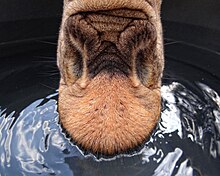
The circulatory system of the giraffe has several adaptations for its great height. Its heart, which can weigh more than 11 kg (25 lb) and measures about 60 cm (2 ft) long, must generate approximately double the blood pressure required for a human to maintain blood flow to the brain. As such, the wall of the heart can be as thick as 7.5 cm (3.0 in).[17] Giraffes have unusually high heart rates for their size, at 150 beats per minute.[41]: 76 When the animal lowers its head the blood rushes down fairly unopposed and a rete mirabile in the upper neck prevents excess blood flow to the brain. When it raises again, the blood vessels constrict and direct the blood into the brain so the animal doesn't faint.[67] The jugular veins contain several (most commonly seven) valves to prevent blood flowing back into the head from the inferior vena cava and right atrium while the head is lowered.[68] Conversely, the blood vessels in the lower legs are under great pressure because of the weight of fluid pressing down on them. To solve this problem, the skin of the lower legs is thick and tight; preventing too much blood from pouring into them.[27]
Giraffes have oesophageal muscles that are unusually strong to allow regurgitation of food from the stomach up the neck and into the mouth for rumination.[41]: 78 They have four chambered stomachs, as in all ruminants, and the first chamber has adapted to their specialised diet.[6] The intestines of an adult giraffe measure more than 70 m (230 ft) in length[69] and have a relatively small ratio of small to large intestine.[69] The liver of the giraffe is small and compact.[41]: 76 A gallbladder is generally present during fetal life, but it may disappear before birth.[6][70][71]
Behaviour and ecology
Habitat and feeding

Giraffes usually inhabit savannahs and open woodlands. They prefer Acacieae, Commiphora, Combretum and open Terminalia woodlands over denser environments like Brachystegia woodlands.[32]: 322 The Angolan giraffe can be found in desert environments.[72] Giraffes browse on the twigs of trees, preferring trees of the subfamily Acacieae and the genera Commiphora and Terminalia,[3] which are important sources of calcium and protein to sustain the giraffe's growth rate.[9] They also feed on shrubs, grass and fruit.[32]: 324 A giraffe eats around 34 kg (75 lb) of foliage daily.[35] When stressed, giraffes may chew the bark off branches. Although herbivorous, the giraffe has been known to visit carcasses and lick dried meat off bones.[32]: 325
During the wet season, food is abundant and giraffes are more spread out, while during the dry season, they gather around the remaining evergreen trees and bushes.[3] Mothers tend to feed in open areas, presumably to make it easier to detect predators, although this may reduce their feeding efficiency.[59] As a ruminant, the giraffe first chews its food, then swallows it for processing and then visibly passes the half-digested cud up the neck and back into the mouth to chew again.[41]: 78–79 It is common for a giraffe to salivate while feeding.[42]: 27 The giraffe requires less food than many other herbivores because the foliage it eats has more concentrated nutrients and it has a more efficient digestive system.[3] The animal's faeces come in the form of small pellets.[6] When it has access to water, a giraffe drinks at intervals no longer than three days.[35]
Giraffes have a great effect on the trees that they feed on, delaying the growth of young trees for some years and giving "waistlines" to trees that are too tall.[35] Feeding is at its highest during the first and last hours of daytime. Between these hours, giraffes mostly stand and ruminate. Rumination is the dominant activity during the night, when it is mostly done lying down.[35]
Social life
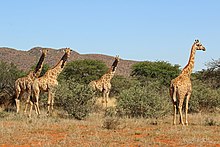
Giraffes are usually found in groups. Traditionally, the composition of these groups has been described as open and ever-changing.[73] Giraffes were thought to have few social bonds and for research purposes, a "group" has been defined as "a collection of individuals that are less than a kilometre apart and moving in the same general direction."[74] More recent studies have found that giraffes do have long-term social associations and may form groups or pairs based on kinship, sex or other factors. These groups may regularly associate with one another in larger communities or sub-communities within a fission–fusion society.[75][76][77] The number of giraffes in a group can range up to 44 individuals.[77]
Giraffe groups tend to be sex-segregated[77] although mixed-sex groups made of adult females and young males are known to occur.[74] Particularity stable giraffe groups are those made of mothers and their young,[74] which can last weeks or months.[78] Social cohesion in these groups is maintained by the bonds formed between calves.[32]: 330 [74] Female association appears to be based on space-use and individuals may be matrilineally related.[77] Young males also form groups and will engage in playfights. However, as they get older males become more solitary but may also associate in pairs or with female groups.[77][78] Giraffes are not territorial,[6] but they have home ranges.[35] Male giraffes occasionally wander far from areas that they normally frequent.[32]: 329
Although generally quiet and non-vocal, giraffes have been heard to communicate using various sounds. During courtship, males emit loud coughs.[35] Females call their young by bellowing. Calves will emit snorts, bleats, mooing and mewing sounds. Giraffes also snore, hiss, moan, grunt and make flute-like sounds,[35][79] and possibly communicate over long distances using infrasound[80]—though this is disputed.[79] During nighttime, giraffes appear to hum to each other above the infrasound range for purposes which are unclear.[79]
Reproduction and parental care
Reproduction in giraffes is broadly polygamous: a few older males mate with the fertile females. Male giraffes assess female fertility by tasting the female's urine to detect oestrus, in a multi-step process known as the flehmen response.[74][78] Males prefer young adult females over juveniles and older adults.[74] Once an oestrous female is detected, the male will attempt to court her. When courting, dominant males will keep subordinate ones at bay.[78] A courting male may lick a female's tail, rest his head and neck on her body or nudge her with his horns. During copulation, the male stands on his hind legs with his head held up and his front legs resting on the female's sides.[35]
Giraffe gestation lasts 400–460 days, after which a single calf is normally born, although twins occur on rare occasions.[81] The mother gives birth standing up. The calf emerges head and front legs first, having broken through the fetal membranes, and falls to the ground, severing the umbilical cord.[6] The mother then grooms the newborn and helps it stand up.[42]: 40 A newborn giraffe is 1.7–2 m (5.6–6.6 ft) tall.[36][37][38] Within a few hours of birth, the calf can run around and is almost indistinguishable from a one-week-old. However, for the first 1–3 weeks, it spends most of its time hiding;[82] its coat pattern providing camouflage. The ossicones, which have lain flat while it was in the womb, become erect within a few days.[35]

Mothers with calves will gather in nursery herds, moving or browsing together. Mothers in such a group may sometimes leave their calves with one female while they forage and drink elsewhere. This is known as a "calving pool".[82] Adult males play almost no role in raising the young,[32]: 337 although they appear to have friendly interactions.[74] Calves are at risk of predation, and a mother giraffe will stand over her calf and kick at an approaching predator.[35] Females watching calving pools will only alert their own young if they detect a disturbance, although the others will take notice and follow.[82] The bond a mother shares with her calf varies, though it can last until her next calving.[82] Likewise, calves may suckle for only a month[32]: 335 or as long as a year.[35][78] Females become sexually mature when they are four years old, while males become mature at four or five years. However, males must wait until they are at least seven years old to gain the opportunity to mate.[35][42]: 40
Necking
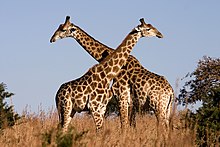

Male giraffes use their necks as weapons in combat, a behaviour known as "necking". Necking is used to establish dominance and males that win necking bouts have greater reproductive success.[13] This behaviour occurs at low or high intensity. In low intensity necking, the combatants rub and lean against each other. The male that can hold itself more erect wins the bout.[35] In high intensity necking, the combatants will spread their front legs and swing their necks at each other, attempting to land blows with their ossicones. The contestants will try to dodge each other's blows and then get ready to counter. The power of a blow depends on the weight of the skull and the arc of the swing.[35] A necking duel can last more than half an hour, depending on how well matched the combatants are.[32]: 331 Although most fights do not lead to serious injury, there have been records of broken jaws, broken necks, and even deaths.[13]
After a duel, it is common for two male giraffes to caress and court each other. Such interactions between males have been found to be more frequent than heterosexual coupling.[83] In one study, up to 94 percent of observed mounting incidents took place between males. The proportion of same-sex activities varied from 30–75 percent. Only one percent of same-sex mounting incidents occurred between females.[84]
Mortality and health

Giraffes have high adult survival probability,[85] and an unusually long lifespan compared to other ruminants,[86] up to 25 years in the wild.[27] Because of their size, eyesight and powerful kicks, adult giraffes are usually not subject to predation.[35] However, they can fall prey to lions and are regular prey for them in Kruger National Park.[87] Nile crocodiles can also be a threat to giraffes when they bend down to drink.[42] Calves are much more vulnerable than adults, and are additionally preyed on by leopards, spotted hyenas and wild dogs.[17] A quarter to a half of giraffe calves reach adulthood.[85][88] The local, seasonal presence of large herds of migratory wildebeests and zebras reduces predation pressure on giraffe calves and increases their survival probability.[89]
Some parasites feed on giraffes. They are often hosts for ticks, especially in the area around the genitals, which has thinner skin than other areas.[6] Tick species that commonly feed on giraffes are those of genera Hyalomma, Amblyomma and Rhipicephalus. Giraffes may rely on red-billed and yellow-billed oxpeckers to clean them of ticks and alert them to danger. Giraffes host numerous species of internal parasite and are susceptible to various diseases. They were victims of the (now eradicated) viral illness rinderpest.[6] Giraffes also suffer from several disorders of the skin.[90][91]
Relationship with humans
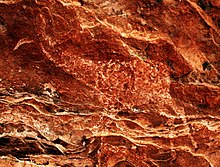
Humans have interacted with giraffes for millennia. The San people of southern Africa have medicine dances named after some animals; the giraffe dance is performed to treat head ailments.[92] How the giraffe got its height has been the subject of various African folktales,[13] including one from eastern Africa which explains that the giraffe grew tall from eating too many magic herbs.[93] Giraffes were depicted in art throughout the African continent, including that of the Kiffians, Egyptians and Meroë Nubians.[42]: 45–47 The Kiffians were responsible for a life-size rock engraving of two giraffes that has been called the "world's largest rock art petroglyph".[42]: 45 [94] The Egyptians gave the giraffe its own hieroglyph, named 'sr' in Old Egyptian and 'mmy' in later periods.[42]: 49 They also kept giraffes as pets and shipped them around the Mediterranean.[42]: 48–49
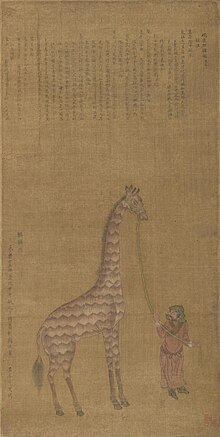
The giraffe was also known to the Greeks and Romans, who believed that it was an unnatural hybrid of a camel and a leopard and called it camelopardalis.[42]: 50 The giraffe was among the many animals collected and displayed by the Romans. The first one in Rome was brought in by Julius Caesar in 46 BC and exhibited to the public.[42]: 52 With the fall of the Western Roman Empire, the housing of giraffes in Europe declined.[42]: 54 During the Middle Ages, giraffes were known to Europeans through contact with the Arabs, who revered the giraffe for its peculiar appearance.[17]
Individual captive giraffes were given celebrity status throughout history. In 1414, a giraffe was shipped from Malindi to Bengal. It was then taken to China by explorer Zheng He and placed in a Ming dynasty zoo. The animal was a source of fascination for the Chinese people, who associated it with the mythical Qilin.[42]: 56 The Medici giraffe was a giraffe presented to Lorenzo de' Medici in 1486. It caused a great stir on its arrival in Florence.[95] Another famous giraffe was brought from Egypt to Paris in the early 19th century as a gift from Muhammad Ali of Egypt to Charles X of France. A sensation, the giraffe was the subject of numerous memorabilia or "giraffanalia".[42]: 81
Giraffes continue to have a presence in modern culture. Salvador Dalí depicted them with burning manes in some of his surrealist paintings. Dali considered the giraffe to be a symbol of masculinity, and a flaming giraffe was meant to be a "masculine cosmic apocalyptic monster".[42]: 123 Several children's books feature the giraffe, including David A. Ufer's The Giraffe Who Was Afraid of Heights, Giles Andreae's Giraffes Can't Dance and Roald Dahl's The Giraffe and the Pelly and Me. Giraffes have appeared in animated films, as minor characters in Disney's The Lion King and Dumbo, and in more prominent roles in The Wild and in the Madagascar films. Sophie the Giraffe has been a popular teether since 1961. Another famous fictional giraffe is the Toys "R" Us mascot Geoffrey the Giraffe.[42]: 127
The giraffe has also been used for some scientific experiments and discoveries. Scientists have looked at the properties of giraffe skin when developing suits for astronauts and fighter pilots[41]: 76 because the people in these professions are in danger of passing out if blood rushes to their legs. Computer scientists have modeled the coat patterns of several subspecies using reaction–diffusion mechanisms.[96]
The constellation of Camelopardalis, introduced in the seventeenth century, depicts a giraffe.[42]: 119–20 The Tswana people of Botswana saw the constellation Crux as two giraffes – Acrux and Mimosa forming a male, and Gacrux and Delta Crucis forming the female.[97]
Exploitation and conservation status
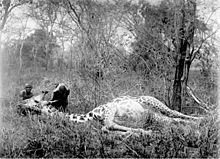
Giraffes were probably common targets for hunters throughout Africa.[32] Different parts of their bodies were used for different purposes.[6] Their meat was used for food. The tail hairs served as flyswatters, bracelets, necklaces and thread.[6][32] Shields, sandals and drums were made using the skin, and the strings of musical instruments were from the tendons.[6] The smoke from burning giraffe skins was used by the medicine men of Buganda to treat nose bleeds.[32] The Humr people of Sudan consume the drink Umm Nyolokh; which is created from the liver and marrow of giraffes. Umm Nyolokh often contains DMT and other psychoactive substances from plants the giraffes eat such as Acacia; and is known to cause hallucinations of giraffes, believed to be the giraffes' ghosts by the Humr.[98][99] In the 19th century, European explorers began to hunt them for sport.[42] Habitat destruction has hurt the giraffe, too: in the Sahel, the need for firewood and grazing room for livestock has led to deforestation. Normally, giraffes can coexist with livestock, since they do not directly compete with them.[27]
In 2010, when the giraffe was seen as one species, it was assessed as Least Concern from a conservation perspective by the International Union for Conservation of Nature (IUCN), as it is still numerous. However, giraffes have been extirpated from much of their historic range including Eritrea, Guinea, Mauritania and Senegal. They may also have disappeared from Angola, Mali, and Nigeria, but have been introduced to Rwanda and Swaziland.[31] Two subspecies, the West African giraffe and the Rothschild giraffe, have been classified as Endangered,[30][33] as wild populations of each of them number in the hundreds.[24] In 1997, Jonathan Kingdon suggested that the Nubian giraffe was the most threatened of all giraffes;[3] as of 2010[update], it may number fewer than 250, although this estimate is uncertain.[24] Private game reserves have contributed to the preservation of giraffe populations in southern Africa.[27] Giraffe Manor is a popular hotel in Nairobi that also serves as sanctuary for Rothschild's giraffes.[100] The giraffe is a protected species in most of its range. It is the national animal of Tanzania,[101] and is protected by law.[102] Unauthorised killing can result in imprisonment.[103] In 1999, it was estimated that over 140,000 giraffes existed in the wild,[24] but estimates in 2016 indicate that fewer than 90,000 remain.[22]
References
- ^ a b c d "Giraffe". Online Etymology Dictionary. Retrieved 1 November 2011.
- ^ Peust, C. (2009). "Some Cushitic Etymologies". Semito-Hamitic Festschrift for A.B. Dolgopolsky and H. Jungraithmayr. Reimer. pp. 257–60. ISBN 3-496-02810-6.
{{cite book}}: Unknown parameter|editors=ignored (|editor=suggested) (help) - ^ a b c d e Kingdon, J. (1997). The Kingdon Field Guide to African Mammals. Academic Press. pp. 339–44. ISBN 0-12-408355-2.
- ^ "Definition of CAMELOPARD". m-w.com. Encyclopædia Britannica: Merriam-Webster. Retrieved 3 September 2014.
- ^ "Definition of camelopard". Dictionary of Medieval Terms and Phrases. Retrieved 3 September 2014.
- ^ a b c d e f g h i j k l m n o p q Dagg, A. I. (1971). "Giraffa camelopardalis" (PDF). Mammalian Species. 5 (5): 1–8. doi:10.2307/3503830. JSTOR 3503830.
- ^ "camelopardalis". A Latin Dictionary, Perseus Digital Library. Retrieved 23 November 2011.
- ^ Carroll., Carroll, Robert Lynn. Robert L. (1 January 1988). "Vertebrate paleontology and evolution /".
{{cite journal}}: Cite journal requires|journal=(help)CS1 maint: multiple names: authors list (link) - ^ a b c d e f g h i j k Mitchell, G.; Skinner, J. D. (2003). "On the origin, evolution and phylogeny of giraffes Giraffa camelopardalis" (PDF). Transactions of the Royal Society of South Africa. 58 (1): 51–73. doi:10.1080/00359190309519935.
- ^ a b c d Danowitz, M.; Vasilyev, A.; Kortlandt, V.; Solounias, V. (2015). "Fossil evidence and stages of elongation of the Giraffa camelopardalis neck". Royal Society Open Science. 2: 150393. doi:10.1098/rsos.150393.
- ^ Danowitz, M.; Domalski, R.; Solounias, N. (2015). "The cervical anatomy of Samotherium, an intermediate-necked giraffid". Royal Society Open Science. 2: 150521. doi:10.1098/rsos.150521.
- ^ "Giraffa (giraffe)". The Paleobiology Database. Retrieved 13 September 2016.
- ^ a b c d e f g h Simmons, R. E.; Scheepers, L. (1996). "Winning by a Neck: Sexual Selection in the Evolution of Giraffe" (PDF). The American Naturalist. 148 (5): 771–86. doi:10.1086/285955.
- ^ Janis, Christine M. (1 January 1993). "Tertiary Mammal Evolution in the Context of Changing Climates, Vegetation, and Tectonic Events". Annual Review of Ecology and Systematics. 24: 467–500.
- ^ Ramstein, Gilles; Fluteau, Frédéric; Besse, Jean; Joussaume, Sylvie (24 April 1997). "Effect of orogeny, plate motion and land–sea distribution on Eurasian climate change over the past 30 million years". Nature. 386 (6627): 788–795. doi:10.1038/386788a0.
- ^ a b c d Badlangana, L. N.; Adams, J. W.; Manger, P. R. (2009). "The giraffe (Giraffa camelopardalis) cervical vertebral column: A heuristic example in understanding evolutionary processes?". Zoological Journal of the Linnean Society. 155 (3): 736–57. doi:10.1111/j.1096-3642.2008.00458.x.
- ^ a b c d e f g h i j Prothero, D. R.; Schoch, R. M. (2003). Horns, Tusks, and Flippers: The Evolution of Hoofed Mammals. Johns Hopkins University Press. pp. 67–72. ISBN 0-8018-7135-2.
- ^ Simmons, R. E.; Altwegg, R. (1 September 2010). "Necks-for-sex or competing browsers? A critique of ideas on the evolution of giraffe". Journal of Zoology. 282 (1): 6–12. doi:10.1111/j.1469-7998.2010.00711.x. ISSN 1469-7998.
- ^ Agaba, M.; Ishengoma, E.; Miller, W. C.; McGrath, B. C.; Hudson, C. N.; Bedoya, R. O. C; Ratan, A.; Burhans, R.; Chikhi, R.; Medvedev, P.; Praul C. A.; Wu-Cavener, L.; Wood, B.; Robertson, H.; Penfold, L.; Cavener, D. R. (2016). "Giraffe genome sequence reveals clues to its unique morphology and physiology". Nature Communication. 7: 11519. doi:10.1038/ncomms11519. PMC 4873664. PMID 27187213.
- ^ a b c d Brown, D. M.; Brenneman R. A.; Koepfli, K-P.; Pollinger, J. P.; Milá, B.; Georgiadis, N. J.; Louis Jr., E. E.; Grether, G. F.; Jacobs, D. K.; Wayne R. K. (2007). "Extensive population genetic structure in the giraffe". BMC Biology. 5 (1): 57. doi:10.1186/1741-7007-5-57. PMC 2254591. PMID 18154651.
{{cite journal}}: CS1 maint: unflagged free DOI (link) - ^ Lever, A-M. (21 December 2007). "Not one but 'six giraffe species'". BBC News. Retrieved 4 March 2009.
- ^ a b c d e f g h i j k l m n Fennessy, Julian; Bidon, Tobias; Reuss, Friederike; Kumar, Vikas; Elkan, Paul; Nilsson, Maria A.; Vamberger, Melita; Fritz, Uwe; Janke, Axel (2016). "Multi-locus Analyses reveal four giraffe species instead of one". Current Biology. doi:10.1016/j.cub.2016.07.036.
- ^ a b c d e f g h "Giraffa". ISIS. 2010. Retrieved 4 November 2010.
- ^ a b c d e f g h i j k l m n o p q "Giraffe – The Facts: Current giraffe status?". Giraffe Conservation Foundation. Retrieved 21 December 2010.
- ^ a b c d Hassanin, A.; Ropiquet, A.; Gourmand, B-L.; Chardonnet, B.; Rigoulet, J. (2007). "Mitochondrial DNA variability in Giraffa camelopardalis: consequences for taxonomy, phylogeography and conservation of giraffes in West and central Africa". Comptes Rendus Biologies. 330 (3): 173–83. doi:10.1016/j.crvi.2007.02.008. PMID 17434121.
- ^ a b c d e f g h i Seymour, R. (2002) The taxonomic status of the giraffe, Giraffa camelopardalis (L. 1758), PH.D Thesis
- ^ a b c d e f g h i j Pellow, R. A. (2001). "Giraffe and Okapi". In MacDonald, D (ed.). The Encyclopedia of Mammals (2nd ed.). Oxford University Press. pp. 520–27. ISBN 0-7607-1969-1.
- ^ "Exhibits". Al Ain Zoo. 25 February 2003. Archived from the original on 29 November 2011. Retrieved 21 November 2011.
- ^ "Nubian giraffe born in Al Ain zoo". UAE Interact. Retrieved 21 December 2010.
- ^ a b Template:IUCN2012.2
- ^ a b c Template:IUCN2012.2
- ^ a b c d e f g h i j k l m n Kingdon, J. (1988). East African Mammals: An Atlas of Evolution in Africa, Volume 3, Part B: Large Mammals. University Of Chicago Press. pp. 313–37. ISBN 0-226-43722-1.
- ^ a b Template:IUCN2012.2
- ^ Brenneman, R. A.; Louis, E. E. Jr; Fennessy, J. (2009). "Genetic structure of two populations of the Namibian giraffe, Giraffa camelopardalis angolensis". African Journal of Ecology. 47 (4): 720–28. doi:10.1111/j.1365-2028.2009.01078.x.
- ^ a b c d e f g h i j k l m n o p q r s t u v w x Estes, R. (1992). The Behavior Guide to African Mammals: including Hoofed Mammals, Carnivores, Primates. University of California Press. pp. 202–07. ISBN 0-520-08085-8.
- ^ a b c Nowak, R. M. (1999). Giraffe Pages 1086–1089 in Walker's Mammals of the World. Volume 1. The Johns Hopkins University Press, Baltimore, USA and London, UK.
- ^ a b c d e Maisano, Sarah. "''Giraffa camelopardalis'' giraffe". Animaldiversity.ummz.umich.edu.
- ^ a b c d e Owen-Smith, R.N. 1988. Megaherbivores: The Influence of Very Large Body Size on Ecology. Cambridge: Cambridge University Press.
- ^ Dagg, A.I. and J. B. Foster (1976/1982): The Giraffe. Its Biology, Behavior, and Ecology. Krieger Publishing Company, Malabar, Florida (Reprint 1982 with updated supplementary material.)
- ^ a b Skinner, J. D.; Smithers, R. H. M. (1990). The mammals of the southern African subregion. University of Pretoria. pp. 616–20. ISBN 0-521-84418-5.
- ^ a b c d e f g h i Swaby, S. (2010). "Giraffe". In Harris, T. (ed.). Mammal Anatomy: An Illustrated Guide. Marshall Cavendish. pp. 64–84. ISBN 0-7614-7882-5.
- ^ a b c d e f g h i j k l m n o p q r s t u v w x y z aa ab ac ad Williams, E. (2011). Giraffe. Reaktion Books. ISBN 1-86189-764-2.
- ^ a b c Mitchell, G.; Skinner, J.D. (2004). "Giraffe thermoregulation: a review". Transactions of the Royal Society of South Africa: Proceedings of a Colloquium on Adaptations in Desert Fauna and Flora. 59 (2): 49–57. doi:10.1080/00359190409519170. ISSN 0035-919X.
- ^ Wood, W. F.; Weldon, P. J. (2002). "The scent of the reticulated giraffe (Giraffa camelopardalis reticulata)". Biochemical Systematics and Ecology. 30 (10): 913–17. doi:10.1016/S0305-1978(02)00037-6.
- ^ a b c d Simmons, R. E.; Altwegg, R. (2010). "Necks-for-sex or competing browsers? A critique of ideas on the evolution of giraffe". Journal of Zoology. 282 (1): 6–12. doi:10.1111/j.1469-7998.2010.00711.x.
- ^ MacClintock, D.; Mochi, U. (1973). A natural history of giraffes. Scribner. p. 30. ISBN 0-684-13239-7.
- ^ Wood, C. (7 March 2014). "Groovy giraffes…distinct bone structures keep these animals upright". Society for Experimental Biology. Retrieved 7 May 2014.
- ^ Garland, T; Janis, C. M. (1993). "Does metatarsal/femur ratio predict maximal running speed in cursorial mammals?" (PDF). Journal of Zoology. 229 (1): 133–51. doi:10.1111/j.1469-7998.1993.tb02626.x.
- ^ Rafferty, John. P (2011). Grazers (Britannica Guide to Predators and Prey). Britannica Educational Publishing. p. 194. ISBN 1-61530-336-7.
- ^ a b Tobler, I.; Schwierin, B. (1996). "Behavioural sleep in the giraffe (Giraffa camelopardalis) in a zoological garden". Journal of Sleep Research. 5 (1): 21–32. doi:10.1046/j.1365-2869.1996.00010.x. PMID 8795798.
- ^ a b c Henderson, D. M.; Naish, D. (2010). "Predicting the buoyancy, equilibrium and potential swimming ability of giraffes by computational analysis". Journal of Theoretical Biology. 265 (2): 151–59. doi:10.1016/j.jtbi.2010.04.007. PMID 20385144.
- ^ a b Naish, D. (January 2011). "Will it Float?". Scientific American. 304 (1): 22. doi:10.1038/scientificamerican0111-22. ISSN 0036-8733.
- ^ Taylor, M. P.; Wedel, M. J. (2013). "Why sauropods had long necks; and why giraffes have short necks". PeerJ. 1: e36. doi:10.7717/peerj.36. PMC 3628838. PMID 23638372.
{{cite journal}}: CS1 maint: unflagged free DOI (link) - ^ a b Van Sittert, S. J.; Skinner, J. D.; Mitchell, G. (2010). "From fetus to adult – An allometric analysis of the giraffe vertebral column". Journal of Experimental Zoology Part B Molecular and Developmental Evolution. 314B (6): 469–79. doi:10.1002/jez.b.21353.
- ^ a b Solounias, N. (1999). "The remarkable anatomy of the giraffe's neck" (PDF). Journal of Zoology. 247 (2): 257–68. doi:10.1111/j.1469-7998.1999.tb00989.x.
- ^ a b du Toit, J. T. (1990). "Feeding-height stratification among African browsing ruminants" (PDF). African Journal of Ecology. 28 (1): 55–62. doi:10.1111/j.1365-2028.1990.tb01136.x.
- ^ Cameron, E. Z.; du Toit, J. T. (2007). "Winning by a Neck: Tall Giraffes Avoid Competing with Shorter Browsers" (PDF). American Naturalist. 169 (1): 130–35. doi:10.1086/509940. PMID 17206591.
- ^ Woolnough, A. P.; du Toit, J. T. (2001). "Vertical zonation of browse quality in tree canopies exposed to a size-structured guild of African browsing ungulates" (PDF). Oecologia. 129 (1): 585–90. doi:10.1007/s004420100771.
- ^ a b Young, T. P.; Isbell, L. A. (1991). "Sex differences in giraffe feeding ecology: energetic and social constraints" (PDF). Ethology. 87 (1–2): 79–89. doi:10.1111/j.1439-0310.1991.tb01190.x.
- ^ Mitchell, G.; van Sittert, S.; Skinner, J. D. (2010). "The demography of giraffe deaths in a drought". Transactions of the Royal Society of South Africa. 65 (3): 165–68. doi:10.1080/0035919X.2010.509153.
- ^ Mitchell, G.; van Sittert, S. J.; Skinner, J. D. (2009). "Sexual selection is not the origin of long necks in giraffes". Journal of Zoology. 278 (4): 281–86. doi:10.1111/j.1469-7998.2009.00573.x.
- ^ Brownlee, A. (1963). "Evolution of the Giraffe". Nature. 200: 1022. doi:10.1038/2001022a0.
- ^ Williams, Edgar M. (2016). "Giraffe Stature and Neck Elongation: Vigilance as an Evolutionary Mechanism". Biology. 5 (3): 35. doi:10.3390/biology5030035.
{{cite journal}}: CS1 maint: unflagged free DOI (link) - ^ a b Wedel, M. J. (2012). "A monument of inefficiency: the presumed course of the recurrent laryngeal nerve in sauropod dinosaurs" (PDF). Acta Palaeontologica Polonica. 57 (2): 251–56. doi:10.4202/app.2011.0019.
- ^ Harrison, D. F. N. (1995). The Anatomy and Physiology of the Mammalian Larynx. Cambridge University Press. p. 165. ISBN 0-521-45321-6.
- ^ a b Skinner, J. D.; Mitchell, G. (2011). "Lung volumes in giraffes, Giraffa camelopardalis" (PDF). Comparative Biochemistry and Physiology A. 158 (1): 72–78. doi:10.1016/j.cbpa.2010.09.003.
- ^ Mitchell, G.; Skinner, J. D. (1993). "How giraffe adapt to their extraordinary shape". Transactions of the Royal Society of South Africa. 48 (2): 207–18. doi:10.1080/00359199309520271.
- ^ Mitchell, G.; van Sittert, S. J.; Skinner, J. D. (2009). "The structure and function of giraffe jugular vein valves" (PDF). South African Journal of Wildlife Research. 39 (2): 175–80. doi:10.3957/056.039.0210.
- ^ a b Pérez, W.; Lima, M.; Clauss, M. (2009). "Gross anatomy of the intestine in the giraffe (Giraffa camelopardalis)". Anatomia, Histologia, Embryologia. 38 (6): 432–35. doi:10.1111/j.1439-0264.2009.00965.x. PMID 19681830.
- ^ Cave, A. J. E. (1950). "On the liver and gall-bladder of the Giraffe". Proceedings of the Zoological Society of London. 120 (2): 381–93. doi:10.1111/j.1096-3642.1950.tb00956.x.
- ^ Oldham-Ott, Carla K.; Gilloteaux, Jacques (1997). "Comparative morphology of the gallbladder and biliary tract in vertebrates: variation in structure, homology in function and gallstones". Microscopy Research and Technique. 38 (6): 571–79. doi:10.1002/(SICI)1097-0029(19970915)38:6<571::AID-JEMT3>3.0.CO;2-I.
- ^ Fennessy, J. (2004). Ecology of desert-dwelling giraffe Giraffa camelopardalis angolensis in northwestern Namibia (Ph.D. thesis). University of Sydney.
- ^ van der Jeugd, H. P; Prins, H. H. T. (2000). "Movements and group structure of giraffe (Giraffa camelopardalis) in Lake Manyara National Park, Tanzania". Journal of Zoology. 251 (1): 15–21. doi:10.1111/j.1469-7998.2000.tb00588.x. Archived from the original (PDF) on 24 April 2012.
{{cite journal}}: CS1 maint: multiple names: authors list (link) - ^ a b c d e f g Pratt D. M.; Anderson V. H. (1985). "Giraffe social behavior". Journal of Natural History. 19 (4): 771–81. doi:10.1080/00222938500770471.
- ^ Bercovitch, F. B.; Berry, P. S. M. (2013). "Herd composition, kinship and fission–fusion social dynamics among wild giraffe". African Journal of Ecology. 51 (2): 206–216. doi:10.1111/aje.12024.
- ^ Carter, K. D.; Seddon, J. M.; Frèreb, C. H.; Carter, J. K. (2013). "Fission–fusion dynamics in wild giraffes may be driven by kinship, spatial overlap and individual social preferences". Animal Behaviour. 85 (2): 385–394. doi:10.1016/j.anbehav.2012.11.011.
- ^ a b c d e VanderWaal, K. L.; Wang, H.; McCowan, B.; Fushing, H.; Isbell, L. A. (2014). "Multilevel social organization and space use in reticulated giraffe (Giraffa camelopardalis)" (PDF). Behavioral Ecology. 25 (1): 17–26. doi:10.1093/beheco/art061.
- ^ a b c d e Leuthold, B. M. (1979). "Social organization and behaviour of giraffe in Tsavo East National Park". African Journal of Ecology. 17 (1): 19–34. doi:10.1111/j.1365-2028.1979.tb00453.x.
- ^ a b c Baotic, A.; Sicks, F.; Stoeger, A. S. (2015). "Nocturnal "humming" vocalizations: adding a piece to the puzzle of giraffe vocal communication". BMC Research Notes. 8: 425. doi:10.1186/s13104-015-1394-3.
{{cite journal}}: CS1 maint: unflagged free DOI (link) - ^ "Silent Sentinels?". PBS online – Nature. Retrieved 21 December 2011.
- ^ "Mammal Guide – Giraffe". Animal Planet. Archived from the original on 4 February 2009. Retrieved 7 March 2009.
- ^ a b c d Langman, V. A. (1977). "Cow-calf relationships in giraffe (Giraffa camelopardalis giraffa)". Zeitschrift für Tierpsychologie. 43 (3): 264–86. doi:10.1111/j.1439-0310.1977.tb00074.x
- ^ Coe, M. J. (1967). "'Necking' behavior in the giraffe". Journal of Zoology. 151 (2): 313–21. doi:10.1111/j.1469-7998.1967.tb02117.x.
- ^ Bagemihl, B. (1999). Biological Exuberance: Animal Homosexuality and Natural Diversity. St. Martin's Press. pp. 391–93. ISBN 0-312-19239-8.
- ^ a b Lee, D. E.; Strauss, M. K. L (1 January 2016). Reference Module in Earth Systems and Environmental Sciences. Elsevier. ISBN 9780124095489.
- ^ Müller, D.W.; Zerbe, P; Codron, D; Clauss, M; Hatt, J.M. (2011). "A long life among ruminants: giraffids and other special cases". Schweizer Archiv für Tierheilkunde. 153 (11): 515–519. doi:10.1024/0036-7281/a000263. PMID 22045457.
- ^ Owen-Smith, N.; Mills, M. G. (2008). "Predator-prey size relationships in an African large-mammal food web" (PDF). Journal of Animal Ecology. 77 (1): 173–83. doi:10.1111/j.1365-2656.2007.01314.x. PMID 18177336.
- ^ Lee, Derek E.; Bond, Monica L.; Kissui, Bernard M.; Kiwango, Yustina A.; Bolger, Douglas T. (11 May 2016). "Spatial variation in giraffe demography: a test of 2 paradigms". Journal of Mammalogy: gyw086. doi:10.1093/jmammal/gyw086. ISSN 0022-2372.
- ^ Lee, Derek E.; Kissui, Bernard M.; Kiwango, Yustina A.; Bond, Monica L. (2016). "Migratory herds of wildebeests and zebras indirectly affect calf survival of giraffes". Ecology and Evolution: n/a–n/a. doi:10.1002/ece3.2561. ISSN 2045-7758.
- ^ Bond, Monica L.; Strauss, Megan K. L.; Lee, Derek E. (16 August 2016). "Soil Correlates and Mortality from Giraffe Skin Disease in Tanzania". Journal of Wildlife Diseases. doi:10.7589/2016-02-047. ISSN 0090-3558.
- ^ Muneza, Arthur B.; Montgomery, Robert A.; Fennessy, Julian T.; Dickman, Amy J.; Roloff, Gary J.; Macdonald, David W. (1 June 2016). "Regional variation of the manifestation, prevalence, and severity of giraffe skin disease: A review of an emerging disease in wild and captive giraffe populations". Biological Conservation. 198: 145–156. doi:10.1016/j.biocon.2016.04.014.
- ^ Ross, K. (2003). Okavango: jewel of the Kalahari. Struik. p. 168. ISBN 1-86872-729-7.
- ^ Greaves, N.; Clement, R. (2000). When Hippo Was Hairy: And Other Tales from Africa. Struik. pp. 86–88. ISBN 1-86872-456-5.
- ^ "The Dabous Giraffe rock art petrograph". The Bradshaw Foundation. Retrieved 6 November 2011.
- ^ Ringmar, E. (2006). "Audience for a Giraffe: European Expansionism and the Quest for the Exotic" (PDF). Journal of World History. 17 (4): 353–97. doi:10.1353/jwh.2006.0060. JSTOR 20079397.
- ^ Walter, M.; Fournier, A.; Menevaux, D. (2001). "Integrating shape and pattern in mammalian models in SIGGRAPH '01" (PDF). Proceedings of the 28th annual conference on Computer graphics and interactive techniques: 317–26. doi:10.1145/383259.383294. ISBN 1-58113-374-X.
- ^ Clegg, A. (1986). "Some Aspects of Tswana Cosmology". Botswana Notes and Records. 18: 33–37. JSTOR 40979758.
- ^ Ian Cunnison (1958). "Giraffe hunting among the Humr tribe". Sudan Notes and Records. 39.
- ^ "6 Animals That Can Get You High".
- ^ Lord. M (11 January 2012). "Outlandish Outposts: Giraffe Manor in Kenya". Forbes.com. Retrieved 4 April 2012.
- ^ Knappert, J (1987). East Africa: Kenya, Tanzania & Uganda. Vikas Publishing House. p. 57. ISBN 0-7069-2822-9.
- ^ Charles Foley; Lara Foley; Alex Lobora; Daniela De Luca; Maurus Msuha; Tim R. B. Davenport; Sarah M. Durant (8 June 2014). A Field Guide to the Larger Mammals of Tanzania. Princeton University Press. pp. 179–. ISBN 978-1-4008-5280-2.
- ^ "National Symbols: National Animal". tanzania.go.tz. Tanzania Government Portal. Retrieved 14 January 2015.
External links
- ARKive – images and movies of the giraffe (Giraffa camelopardalis).
- Giraffe, African Wildlife Foundation
- Giraffa camelopardalis, Encyclopedia of Life
- Giraffe fight on YouTube from BBC's Africa series



